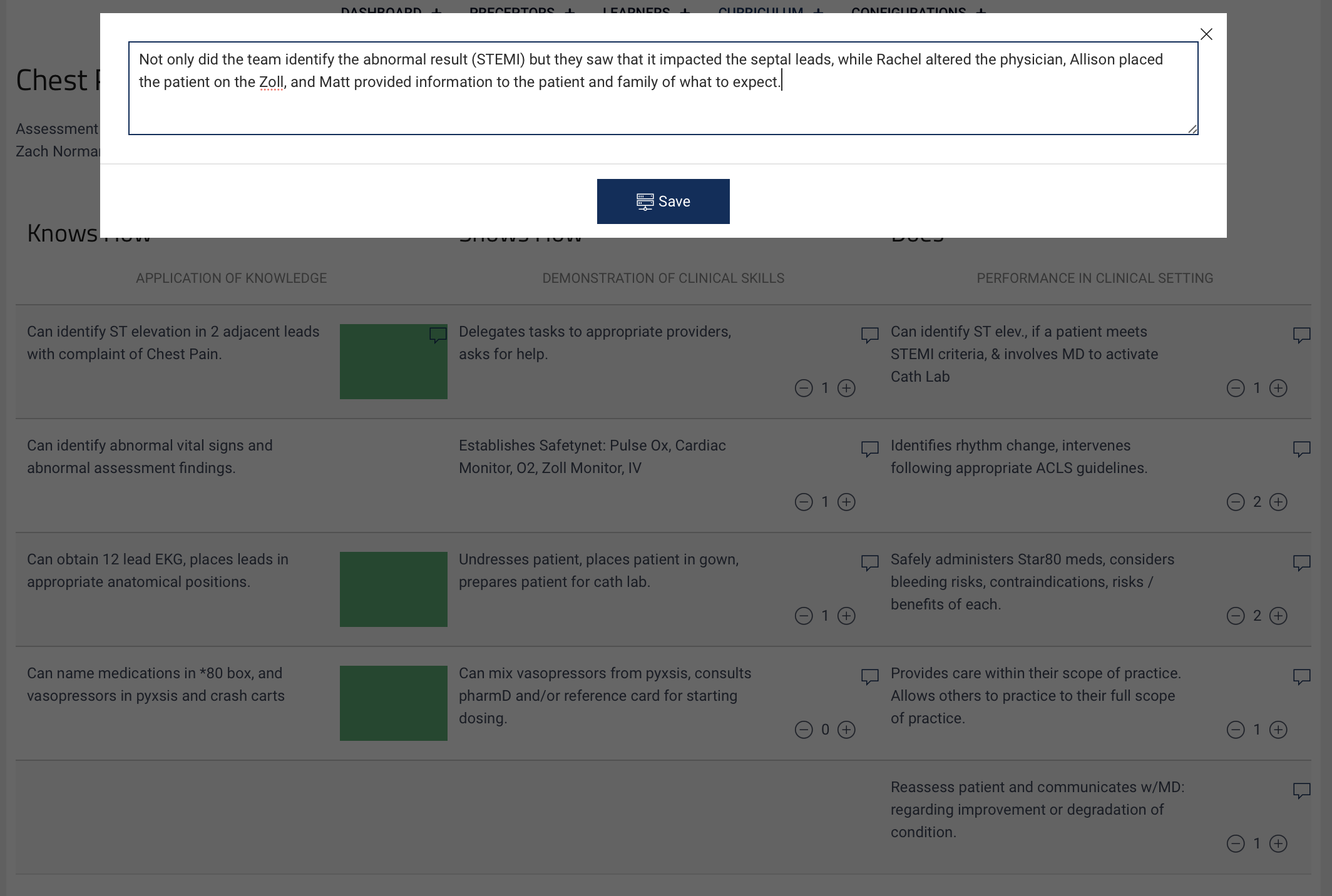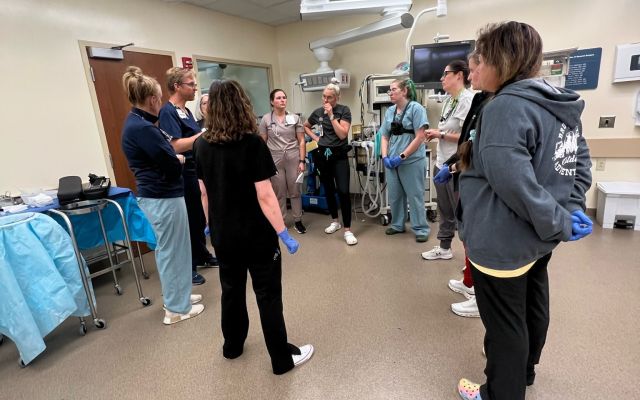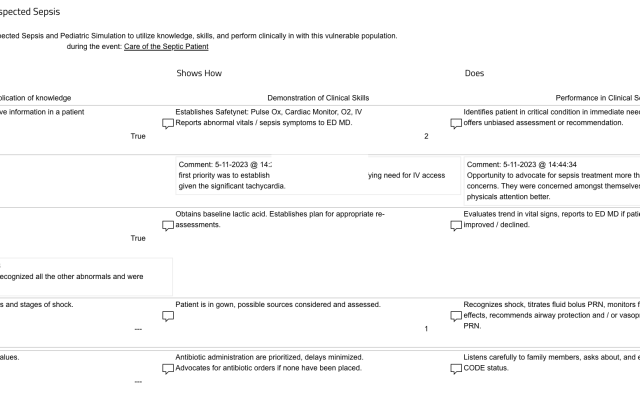Clinical Development Grid
Project: Improving Simulation Debriefing
Innovation
Identify participant actions during simulation
Topic
Simulation Debriefing
The clinical development grid is designed to capture the real-time assessment of the simulation participants' performance. The grid is divided into four columns, moving from left to right, representing advancement in knowledge, skill application, and exercise of appropriate clinical judgment.
- Knows: attests the participant has baseline knowledge; for example, Attends didactic learning associated with the topic.
- Knows How: indicates the participant can utilize the knowledge; for example, Can Identify abnormal vital signs.
- Shows How: stipulates the participant matched knowledge to a situation; for example, Establishes Safety net: places the patient on a cardiac monitor and obtains IV access.
- Does: reveals the participant's ability to exercise clinical judgment; they can use knowledge and skills in the appropriate situation to initiate, advocate for, or recommend the following steps the team should take; for example: Identifies a patient in critical condition, obtains an MD, and communicates the concerns.
Learning occurs by Watching, Participating, and Reflecting on a Simulation
The clinical development grid measures performance from basic knowledge (Knows) on the left to more advanced practice application on the right (Does). The evaluator can input a comment on each item on the grid. The comments are timestamped and can be matched with video playback of the simulation. Using the clinical development grid and the video playback, the simulation facilitator can assist a participant in reflecting on their thoughts or actions in different clinical scenarios.
Challenge
Learner Disengagement during Simulation
Throughout several cohorts of learners, the simulation facilitators noted that learners who received high marks in their ability to independently practice the various elements of clinical judgment struggled during simulation. We started to consider the factors such as nervousness, the pressure to perform, and the stress of deciding the next steps. In the live environment, many had developed relationships with their preceptors and providers and found ways to validate their plan before implementing it.
Solution
Identify Learner Barriers
Using a clinical development grid in a simulated case effectively assesses learners' performance by evaluating their ability to integrate knowledge, skills, and clinical judgment. Using a standardized method, such as the clinical development grid, allows educators to systematically analyze how well a learner can apply theoretical knowledge to a practical scenario, make informed decisions, and demonstrate critical thinking. The grid helps identify strengths and areas for improvement, which enables the educator to provide targeted feedback to the learner and tailor learning experiences.
Planning
Establish Learning Objectives
The education developers can create a structured framework for assessing learners' progress and achievement by aligning case objectives with the grid's criteria. Aligning the case objectives ensures that each element of the case is evaluated, such as diagnostic skills, treatment decisions, communication, and critical thinking, about the predetermined learning goals. Aligning the objectives helps the orientation team provide a comprehensive view of the learners' abilities and how well they can meet specific clinical objectives within the simulation context.
-
Objective: Statement in the plan/design of the case that signals a desired action for the participant to achieve. Each goal should be written to be achievable and measurable on the clinical development grid.
-
Clinical Development Grid:
- Knows How: Application of Knowledge
- Shows How: Demonstration of clinical skills
- Does: Performance in the clinical setting
-
Objective: Recognize Abnormal Vital Signs
-
Clinical Development Grid:
- Knows How: Recognizes abnormal Vital Sign
- Shows How: Establishes safety net (Monitor, IV, O2) and re-assesses at regular intervals
- Does: Alerts physician to patient in compensated shock and recommends IV fluid bolus and evaluation for sepsis.
Evaluate
Assess Learner Development and Communicate ROI
Not only can this tool be used to quantify improvements a learner has made, but it also can be used to demonstrate Return on Investment (ROI) to a leader.
Using the clinical development grid can identify specific areas where the learner has improved their performance. The performance evaluation could include enhanced clinical judgment, better decision-making, improved communication skills, and more. With each simulation session, the learner should demonstrate an improvement in knowledge and skill application, leading to independent nursing practice as a well-rounded, capable registered nurse who can anticipate patient care needs.
The Clinical Development Grid visually represents the learner's progress and improvements clearly and concisely.

Additional Opportunities:
-
Highlight Positive Outcomes: Illustrate how the learner's enhanced skills and clinical judgment directly translate to better patient care, increased efficiency, and improved safety in real-world clinical settings.
-
Case Studies or Testimonials: Showcase instances where improved learner performance led to positive outcomes.
-
Long-term Gains: Emphasize how the skills and insights gained through this development will continue to benefit the organization in the long run, positively affecting patient outcomes, team collaboration, and overall quality of care.
Schedule a Demonstration
saving...


